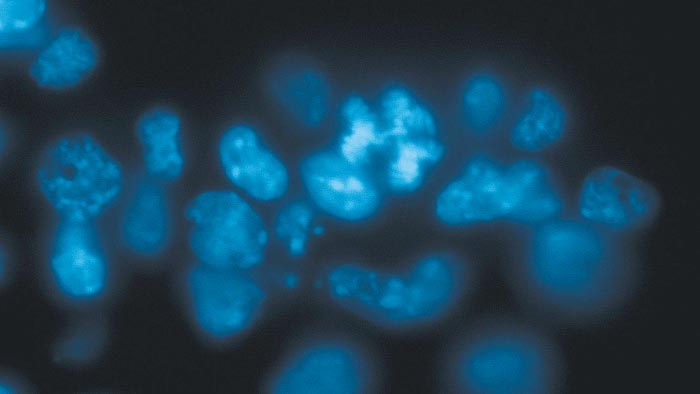Stabilizing chromosomes to tackle tumors

A mouse cell is dividing abnormally in the center of this image. Instead of dividing its chromosomes equally into two cells, the cell is dividing into three cells. Chromosomes are stained in blue. These cells have a mutation in the gene dicer, which makes a protein that stabilizes chromosomes. Dicer makes sure the chromosomes divide and segregate evenly during cell division.
Credit: Michael Gutbrod/Martienssen lab/CSHL, 2022
Cells use RNA as a versatile tool to regulate the activity of their genes. Small snippets of RNA can fine-tune how much protein is produced from various genes; some small RNAs can shut genes off altogether. An enzyme called Dicer chops RNA into smaller pieces: plants use it to chew up the RNA of invading viruses; worms use it to shut genes off during development; and humans use it to produce gene-regulating microRNAs. Dicer is also of interest because mutations in the gene for the enzyme appear to contribute to some human cancers, although it hasn’t been clear exactly why.
In a new study published February 22, 2022 in the journal Nature Communications, researchers led by Cold Spring Harbor Laboratory Professor Rob Martienssen found an unexpected role for Dicer in mammalian cells: they’ve discovered that the enzyme is important for maintaining the structural integrity of the genome.
When Martienssen’s team removed Dicer from the embryonic stem cells of mice, the cells became sick. Chromosomes inside dividing cells couldn’t properly align themselves for equal distribution to daughter cells. Cell division slowed, and many cells died. Martiennsen’s team had seen this before when they removed Dicer from yeast cells. And when they explored further, they found that Dicer stabilizes the mouse genome in much the same way it maintains the genome in yeast, suggesting that this is an evolutionarily ancient role for the enzyme.
“The new function that we have identified for Dicer genome stability, independently of other well-known small RNA pathways could be an explanation of why Dicer mutations are an important factor in certain types of cancer,” says Benjamin Roche, a researcher in Martienssen’s lab.
Normally, Dicer works with a gene-activating protein called BRD4. The research team found that when Dicer was broken and BRD4 was intact, chromosomes were unstable. Removing a small piece of BRD4 (called bromodomain 2) restored chromosome stability. Like Dicer, BRD4 is often mutated in human cancers. Martienssen says, “Our findings suggest that inhibitors that target BRD4 bromodomain 2 might have specific therapeutic effects when Dicer is compromised in cancer.” The work suggests a new diagnostic and treatment strategy for cancers with compromised Dicer systems using BRD4-targeted drugs.
Journal: Nature Communications
DOI: 10.1038/s41586-021-04010-3
Article Title: Dicer promotes genome stability via the bromodomain transcriptional co-activator BRD4
Article Publication Date: 22-Feb-2022
Media Contact
Sara Roncero-Menendez
Cold Spring Harbor Laboratory
roncero@cshl.edu
Office: 516-367-6866
All latest news from the category: Life Sciences and Chemistry
Articles and reports from the Life Sciences and chemistry area deal with applied and basic research into modern biology, chemistry and human medicine.
Valuable information can be found on a range of life sciences fields including bacteriology, biochemistry, bionics, bioinformatics, biophysics, biotechnology, genetics, geobotany, human biology, marine biology, microbiology, molecular biology, cellular biology, zoology, bioinorganic chemistry, microchemistry and environmental chemistry.
Newest articles

Bringing bio-inspired robots to life
Nebraska researcher Eric Markvicka gets NSF CAREER Award to pursue manufacture of novel materials for soft robotics and stretchable electronics. Engineers are increasingly eager to develop robots that mimic the…

Bella moths use poison to attract mates
Scientists are closer to finding out how. Pyrrolizidine alkaloids are as bitter and toxic as they are hard to pronounce. They’re produced by several different types of plants and are…

AI tool creates ‘synthetic’ images of cells
…for enhanced microscopy analysis. Observing individual cells through microscopes can reveal a range of important cell biological phenomena that frequently play a role in human diseases, but the process of…





















